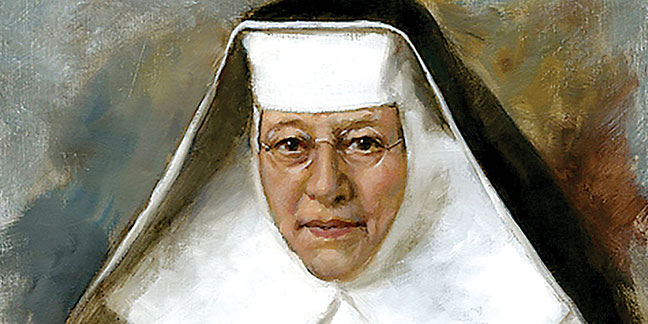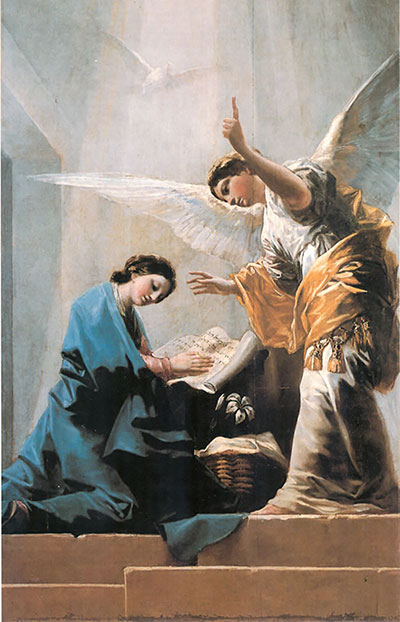
Feast day March 3
On March 3, the Church celebrates the feast of St. Katharine Drexel, a Philadelphia heiress who abandoned her family’s fortune to found an order of sisters dedicated to serving the impoverished African American and Native American populations of the United States.
St. Katharine Drexel was born Nov. 26, 1858, into the affluent Philadelphia Drexel family. Despite their wealth, the family was very pious, and Katharine was taught charity at an early age. Her mother opened up the family house three times a week to feed and care for the poor, and her father had a deep personal prayer life.
During the summer months, Katharine and her sisters taught catechism classes to the children of the workers on her family’s summer estate.
The young heiress was considering a vocation to the contemplative life when she was given the opportunity to travel to Europe and have an audience with the pope. During the audience, she asked Pope Leo XIII to send missionaries to Wyoming. He replied by asking her why she didn’t found an order to do exactly that.
Upon her return home, Katharine began working as a layperson for the improvement of the conditions and education of African Americans and Native Americans. Eventually, her work led her to found the Sisters of the Blessed Sacrament, who are dedicated to sharing the message of the Gospel and the Life of the Eucharist with African Americans and Native Americans.
During her lifetime, she oversaw the opening and maintenance of almost 60 schools and missions, most of which were located in the western and southwestern United States.
From the age of 33 until her death in 1955, she dedicated her life and a fortune of $20 million to this work. In 1894, she took part in opening the first mission school for Native
Americans, in Santa Fe, N.M. Other schools quickly followed for Native Americans west of the Mississippi River and for blacks in the South. In 1915 she also founded Xavier University in New Orleans. At her death there were more than 500 sisters teaching in 63 schools throughout the country.
She was forced into retirement for the last 20 years of her life after she was debilitated by a severe heart attack. Though she was not able to actively lead the order, she left the sisters with her charism of love and concern for the missions.
She died on March 3, 1955, and was canonized by Pope John Paul II on Oct. 1, 2000.
A Saint comes to the Diocese
St. Katharine Drexel played a crucial role in the creation of Belmont Abbey in Belmont.
In 1892, Abbot Leo Haid, the founding abbot of Mary Help of Christians Basilica (better known as Belmont Abbey) set out to build a cathedral. In the summer of 1893, however, the project ran out of money. With the help of Father Francis Meyer, then pastor of St. Peter Church in Charlotte, Abbot Haid was able to secure a gracious donor. That donor was Mother
Katharine Drexel, and her donation came with one stipulation: The new church had to have an appropriate number of pews for the sole use of African Americans.
Abbot Leo Haid also recognized the importance of breaking down “the ugly prejudices” against African Americans. So, he wrote Mother Drexel and told her he saw “no reason why I should not gratefully accept your generous offer.” In 1904, when she visited Belmont Abbey, she found an entire row of pews running the length of the church exclusively for African Americans.
The pews are used in the church today, and will be preserved as St. Peter Church undergoes renovations in the coming year.
In 1899, St. Katharine Drexel also donated funds to build St. Benedict Church in Greensboro, again with the stipulation that pews be reserved for African Americans and that the “same care and attention” white people received would be extended to African Americans. On the left-hand side of the sanctuary today stands a statue of St. Katharine Drexel, honoring her aid for the parish and life of service to others.
To learn more, check out "My Lord Of Belmont: A Biography of Leo Haid" by Paschal Baumstein.
Learn more
The St. Katharine Drexel Mission Center and National Shrine in Bensalem, Pa., offers retreat programs, historic site tours, days of prayer, presentations and lectures about her legacy. Her tomb lies under the main altar in St. Elizabeth Chapel. For more about this American saint, visit her Web site, www.KatharineDrexel.org.
Bishop Jugis gives Catholic schools day off in honor of St. Katharine Drexel
Bishop Peter Jugis gave students in the diocese’s Catholic Schools a “Bishop’s Day off from school” on Monday, March 4, in honor of the feast of St. Katharine Drexel. The gesture honors the special connection the saint has to the diocese, as well as the schools’ mission as educators and the hard work of students as they pursue their vocations and academic excellence.
Did you know?
A second-class relic of St. Katharine can be found inside the altar of the Mary chapel at St. Raphael the Archangel Church in Raleigh.
— Catholic News Herald
Feast celebrated March 25
 The Feast of the Annunciation celebrates the Incarnation of Our Savior – “the Word became flesh and dwelt among us” (John 1). God loved us so much that He chose to become one of us, taking on our humanity so completely that He became as utterly weak and dependent as an infant.
The Feast of the Annunciation celebrates the Incarnation of Our Savior – “the Word became flesh and dwelt among us” (John 1). God loved us so much that He chose to become one of us, taking on our humanity so completely that He became as utterly weak and dependent as an infant.
Our celebration of the Annunciation and the Incarnation affirms that human life begins at conception. God became man not with His birth nine months from now on Dec. 25, but at the moment of His conception in the womb of His mother, Mary. Thus the Feast of the Annunciation teaches us important lessons about the inestimable value God places on human life from the moment of conception. It also reminds us that although we understand best what we can see, the invisible, the hidden, is no less real for our lack of seeing it.
Try the beloved Catholic tradition of planting marigold seeds (named in honor of Mary) in your garden or in little pots on a window sill on the Feast of the Annunciation. Wait to see them sprout and grow. While you and your children are planting these seeds, talk about the importance of God’s “hidden” work. As a baby grows unseen within his mother’s womb, and as the sprouting seed invisibly grows under the soil, so is much essential and vital work people do not visible to most people, and may never be known except to God.
Further meditate on the beauty of the Annunciation by reading the Gospel of St. Luke 1:26-56, the Gospel of St. John Chapter 1, Psalm 139 or the Catechism of the Catholic Church 430-511.
— Sources: Diocese of Peoria Office of Respect Life and Human Dignity and the Respect Life Board; EWTN; Marian Devotions in the Domestic Church
 Prayer for Life
Prayer for Life
O Mary, bright dawn of the new world, Mother of the living, to you do we entrust the cause of life: Look down, O Mother, upon the vast numbers of babies not allowed to be born, of the poor whose lives are made difficult, of men and women who are victims of brutal violence, of the elderly and the sick killed by indifference or out of misguided mercy. Grant that all who believe in your Son may proclaim the Gospel of life with honesty and love to the people of our time. Obtain for them the grace to accept that Gospel as a gift ever new, the joy of celebrating it with gratitude throughout their lives and the courage to bear witness to it resolutely, in order to build, together with all people of good will, the civilization of truth and love, to the praise and glory of God, the Creator and lover of life.
— St. John Paul II, from his encyclical “The Gospel of Life” (March 25,1995)


 Prayer for Life
Prayer for Life